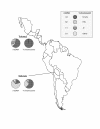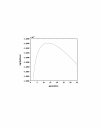Genetic analysis of ancestry, admixture and selection in Bolivian and Totonac populations of the New World
- PMID: 22606979
- PMCID: PMC3432609
- DOI: 10.1186/1471-2156-13-39
Genetic analysis of ancestry, admixture and selection in Bolivian and Totonac populations of the New World
Abstract
Background: Populations of the Americas were founded by early migrants from Asia, and some have experienced recent genetic admixture. To better characterize the native and non-native ancestry components in populations from the Americas, we analyzed 815,377 autosomal SNPs, mitochondrial hypervariable segments I and II, and 36 Y-chromosome STRs from 24 Mesoamerican Totonacs and 23 South American Bolivians.
Results and conclusions: We analyzed common genomic regions from native Bolivian and Totonac populations to identify 324 highly predictive Native American ancestry informative markers (AIMs). As few as 40-50 of these AIMs perform nearly as well as large panels of random genome-wide SNPs for predicting and estimating Native American ancestry and admixture levels. These AIMs have greater New World vs. Old World specificity than previous AIMs sets. We identify highly-divergent New World SNPs that coincide with high-frequency haplotypes found at similar frequencies in all populations examined, including the HGDP Pima, Maya, Colombian, Karitiana, and Surui American populations. Some of these regions are potential candidates for positive selection. European admixture in the Bolivian sample is approximately 12%, though individual estimates range from 0-48%. We estimate that the admixture occurred ~360-384 years ago. Little evidence of European or African admixture was found in Totonac individuals. Bolivians with pre-Columbian mtDNA and Y-chromosome haplogroups had 5-30% autosomal European ancestry, demonstrating the limitations of Y-chromosome and mtDNA haplogroups and the need for autosomal ancestry informative markers for assessing ancestry in admixed populations.
Figures





References
-
- Bolton HE, Marshall TM. The colonization of North America 1492–1783. The Macmillan Company, New York; 1920.
-
- Perego UA, Achilli A, Angerhofer N, Accetturo M, Pala M, Olivieri A, Kashani BH, Ritchie KH, Scozzari R, Kong QP, Myres NM, Salas A, Semino O, Bandelt HJ, Woodward SR, Torroni A. Distinctive Paleo-Indian migration routes from Beringia marked by two rare mtDNA haplogroups. Curr Biol. 2009;19(1):1–8. doi: 10.1016/j.cub.2008.11.058. - DOI - PubMed
-
- Perego UA, Angerhofer N, Pala M, Olivieri A, Lancioni H, Kashani BH, Carossa V, Ekins JE, Gomez-Carballa A, Huber G, Zimmermann B, Corach D, Babudri N, Panara F, Myres NM, Parson W, Semino O, Salas A, Woodward SR, Achilli A, Torroni A. The initial peopling of the Americas: a growing number of founding mitochondrial genomes from Beringia. Genome Res. 2010;20(9):1174–1179. doi: 10.1101/gr.109231.110. - DOI - PMC - PubMed
Publication types
MeSH terms
Substances
Associated data
- Actions
Grants and funding
LinkOut - more resources
Full Text Sources
Molecular Biology Databases
Research Materials

